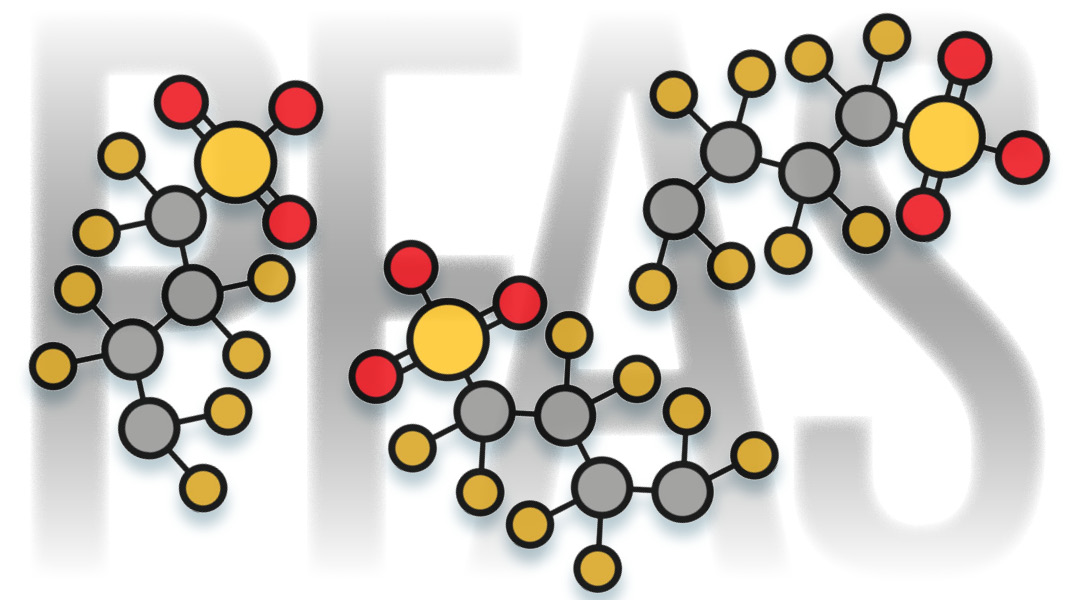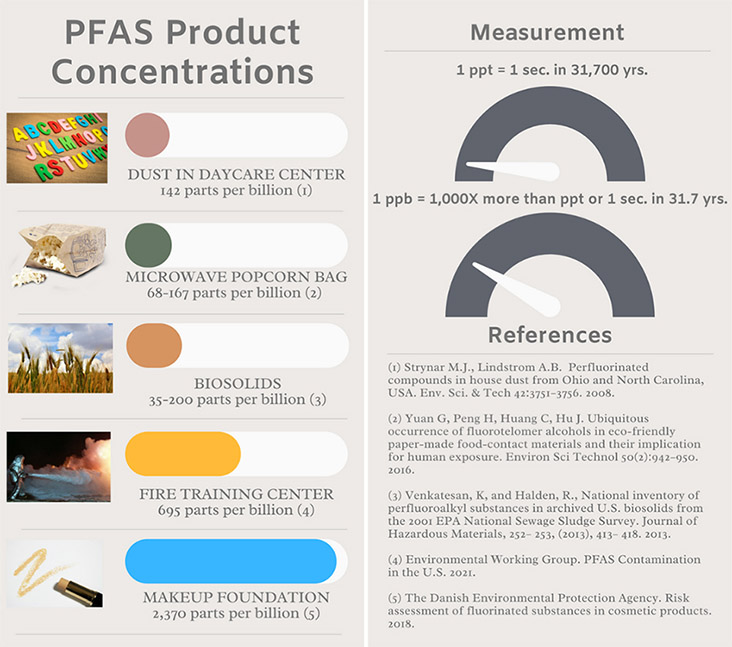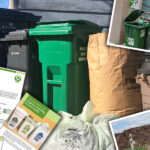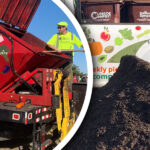Top: Illustration of a short-chain PFAS compound with 6 or fewer carbon molecules, represented above by the grey circles.
 Sally Brown
Sally Brown
Wastewater treatment and large-scale composting are often referred to as industries. While it is true that they make things, what they produce is a far cry from the typical image of industrial production. Wastewater plants — often referred to as resource recovery facilities — make clean water, green energy and soil conditioners from water that has been contaminated by disease-causing pathogens. The plants get rid of the pathogens and in the process, create this range of products. Composting facilities take wastes — rotten food, dead vegetation, animal manures, dead critters — and turn them into soil conditioners. In the process they take out the yuck, the smell and also any pathogens. To me this sounds transformative rather than industrial.
When I think of industries, I think of factories that make pipes, planes, parts and other products that you don’t find on a walk through the woods or in your garden (pink flamingoes and shovels aside, that is). This manufacture can involve a range of ingredients and components, some of which have familiar names and some of which clearly originate in another, chemically-based manufacturing process. These are the type of industries that manufacture and use perfluorinated organic compounds aka PFAS. The term perfluorinated may sound like code but all that it means is that there are multiple fluorine (F) atoms involved, in this case attached to carbon (C) atoms. The bond between C and F is very strong and difficult to break, meaning that once manufactured these bonds and associated compounds hang around for a very long time, hence the term “forever chemicals.”
How widely are these “forever chemicals” used? It is hard to say because in the U.S. — unless you manufacture large quantities of specific chemicals — you don’t have to report their use. As stated in TOSCA (the U.S. Toxic Substances Control Act), unless you manufacture or import more than 25,000 pounds of a compound, your lips are legally sealed. While you are required to list the ingredients for products meant to be eaten by people, you are not required to list ingredients for things that we use. Take your cellphone for example. Where on the package are the ingredients for manufacture listed? I can tell you the memory and camera capabilities and ringtone options, but nowhere is the iPhone required to tell me if PFAS compounds were used in its manufacture.
Newer, Shorter Versions Proliferate
Listing ingredients aside, it is also problematic for those who analyze for these compounds because of the vast number of them in manufacture and use. True, the two historical bad boys, PFOA and PFOS, and other long chain PFAS (≥ 6 perfluoroalkyl carbons) are no longer manufactured in the U.S. With bans, we have seen our body burdens (i.e., levels in our blood stream) of those compounds decrease gradually over time.
Their ban was not taken as a sign to stop making compounds that contain those bonds, however. Instead, newer, shorter versions have proliferated. Over 9,000 versions of these bonds are currently in active manufacture, perfectly legal and not required to be listed as ingredients on any number of products. Instead of analyzing for 10 or 20 or even 30 types of PFAS, the scientific community has now taken to analyzing for the presence of a C-F bond, or classes of PFAS compounds. One recent study analyzed for 160 PFAS chemicals in 42 separate classes (Munoz et al., 2022). They found that today’s composts contain zwitterionic fluorotelomers. The fluorotelomer sulfonamidopropyl betaines are said to be the new, up and coming category in urban residuals. In fact, a relatively new definition of these compounds are carbon chains that contain -CnFa somewhere in their structure (Buck et al., 2011). You can just imagine the possibilities.
A recent study tried to identify the range of applications where these compounds are used (Glüge et al., 2020). This was no small effort because of the wide range of compounds and lack of disclosure requirements for their use. The appendix to the paper included an 11-page list of different categories of use, sub-uses within those categories and justification for use. Here are two random categories and some of their uses within those categories.
- Medical Utensils: CRT, PET, MRI scanners; video endoscope; ultrasound contrast agents; X-ray; NMR imaging; tomography and sonography; contact lenses; surgical gowns; eye drops; catheters, stents, needles; dental floss; etc.
- Sporting Goods: Ski wax; sailing boat equipment; tennis rackets; bicycles; climbing ropes; fishing lines; golf gloves
Impacts At Lower Concentration
A recent brief from the National Institutes of Health (NIH) suggests that maybe we need to be concerned about this whole class of compounds. The title of the brief pretty much says it: “Emerging PFAS can cause changes in gene expression and lipid accumulation in human liver cells” (NIH, 2022). The brief goes on to say that these changes occurred at lower concentrations compared to the PFAS compounds that are no longer in use. In other words, it seems like it is clearly time to stop or at least reduce the use of these compounds in products where they are not absolutely necessary. Lipstick and food packaging are two applications that come to mind.
So that is the reality of the situation, at least in my mind. As I have talked about previously, if you are concerned about a compound, ban or restrict its use. That approach has shown to be effective with PFOA and PFOS. It has worked for people and it has also worked for municipal biosolids. As the literature shows and as my colleague from Maine says, the biosolids that are currently produced in Maine and across the U.S. are almost all low in these forever chemicals. Many have the same concentrations of them that people do. The latest Centers for Disease Control (CDC) survey showed that 98% of the blood sampled had detectable concentrations of forever chemicals. If it is in our blood, our dental floss, our gym bags, our carpets, our food packaging, no wonder it is also in our wastewater (see graphic above from the Water Environment Federation).
Exposure Continues — With Or Without Recycling Organics
If these compounds are truly hazardous, the answer clearly is to limit production and use of them as much as possible. Banning biosolids and closing composting facilities will have no impact on exposure to forever chemicals.
If you go however, to the press, federal agencies, or the state regulatory agencies instead of my mind, very often you get a very different take. Ban the biosolids and close the composting facility have taken precedence over limiting use and manufacture of these compounds. These sources seem to have lost sight of the fact that composters and wastewater treatment plants are on the receiving end, not the manufacturing end. Just like people who have these compounds in their blood. Just like fish in the oceans that have high body burdens of these compounds. Just like many soils that have never seen compost or biosolids. The graphic above from the Water Environment Federation puts this into a clear perspective.
Yes, it is true that decades ago, before the bans of the longer chain compounds, a small number of these facilities accepted wastes and feedstocks that had high concentrations of the now banned compounds. Stopping production now or banning the products will not remedy old errors. It will not reduce exposure or risk. It will hurt our “industry,” perhaps to a point where it won’t recover. It will hurt the lands and the people that rely on our products. It will hurt the environment and the climate. It will cost our ratepayers more. And it won’t accomplish its stated goal — to reduce exposure to these compounds.
Wastewater plants and compost facilities are not the industries to target here. They are on the receiving end, just like we are.
Sally Brown, BioCycle Senior Adviser, is a Research Professor at the University of Washington in the College of the Environment.














